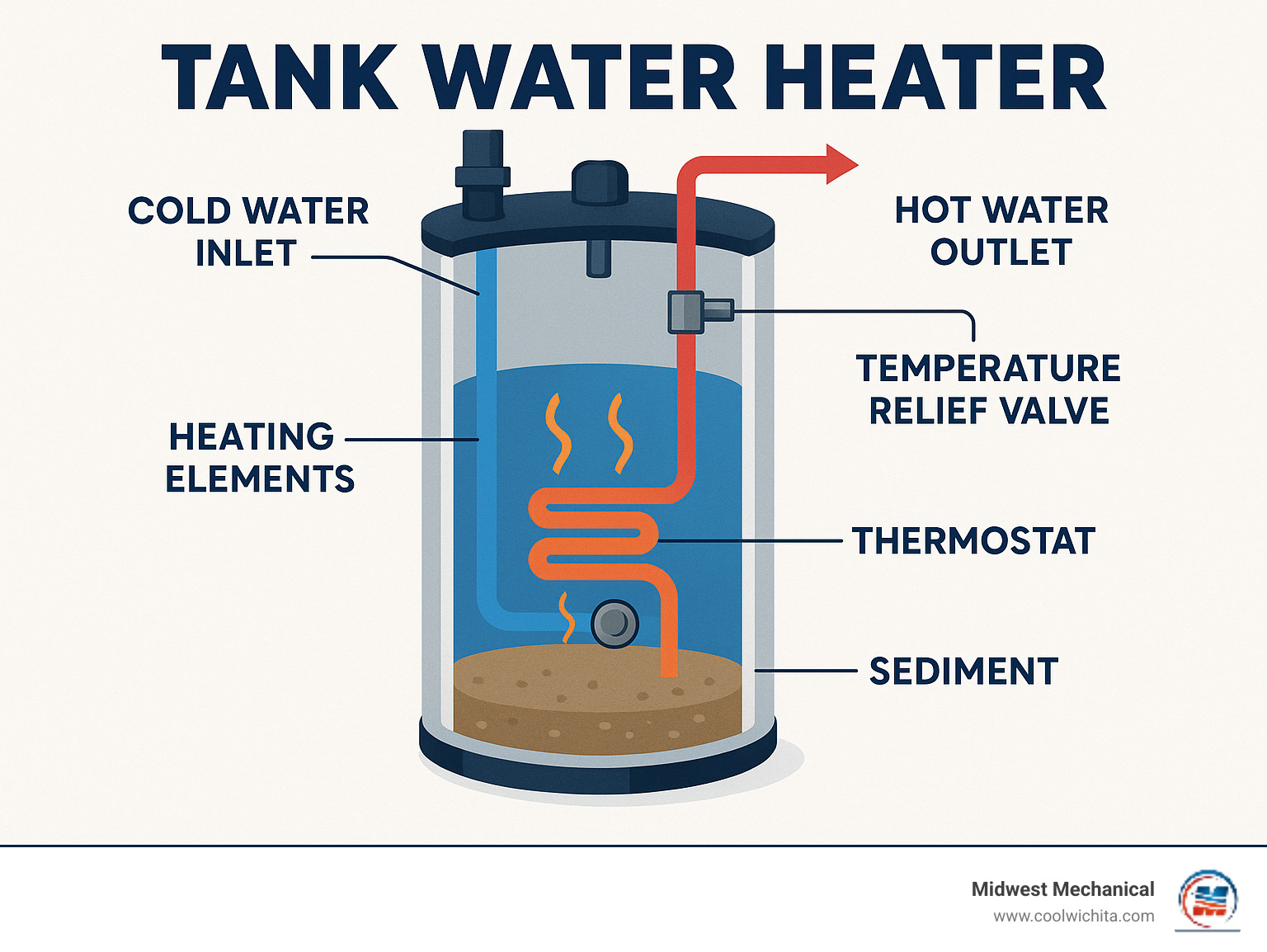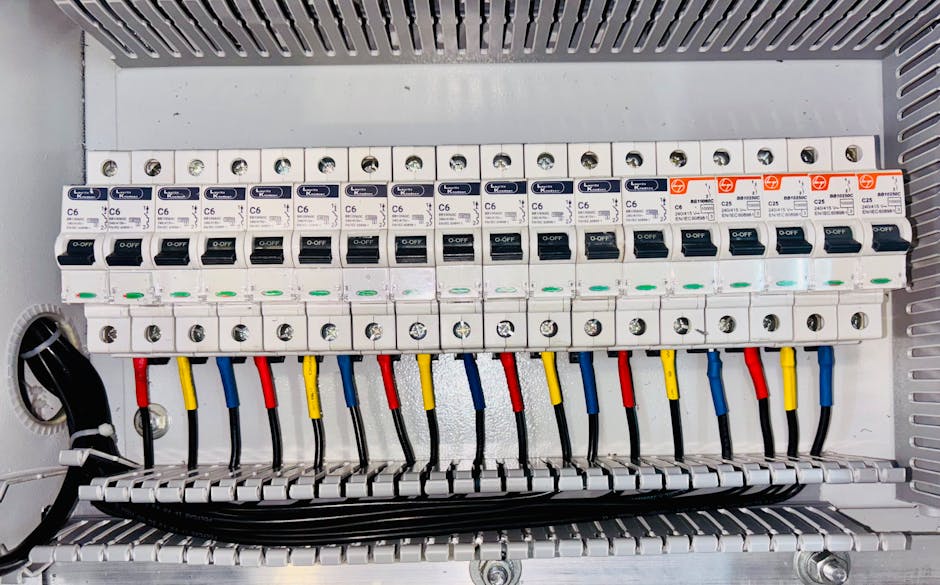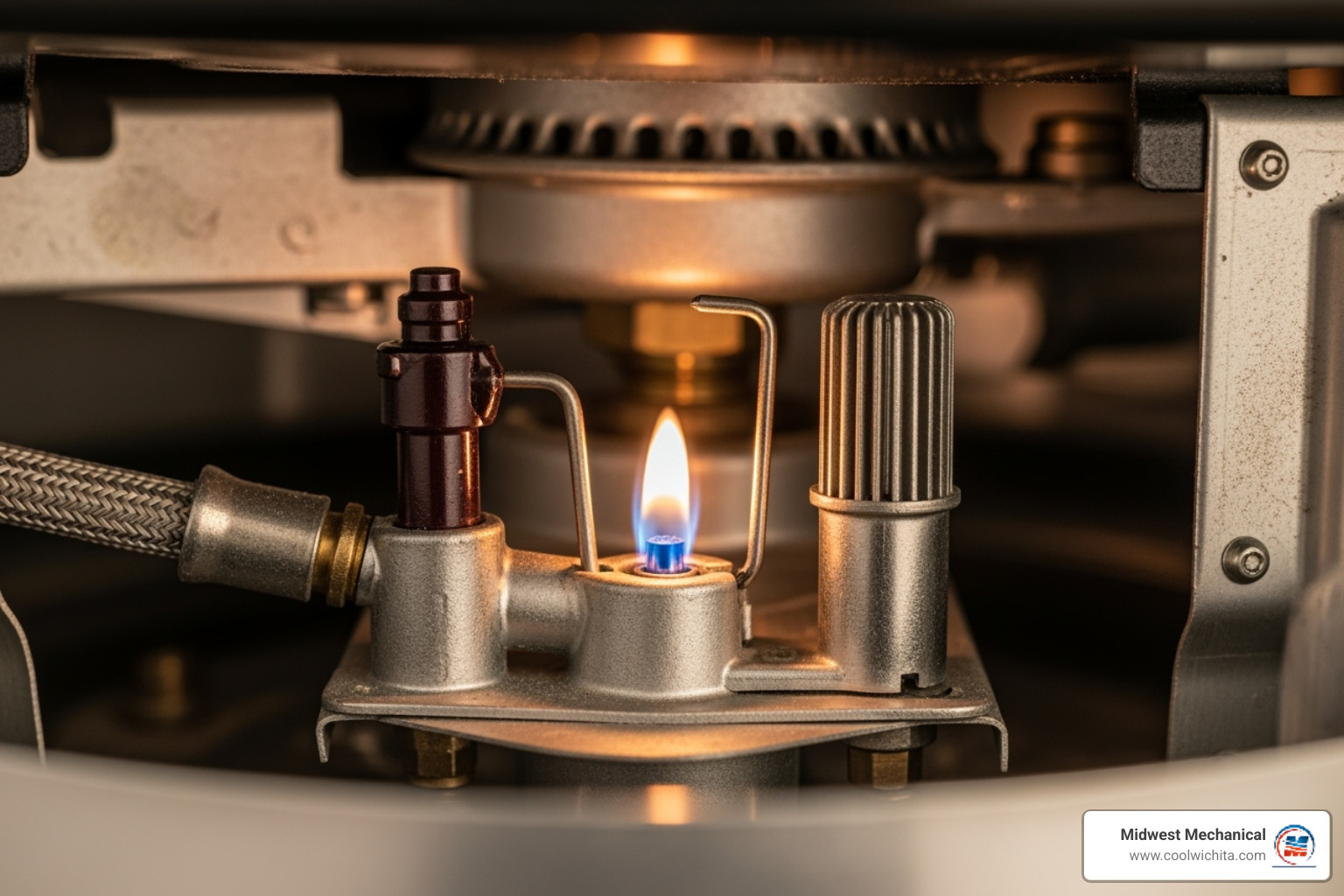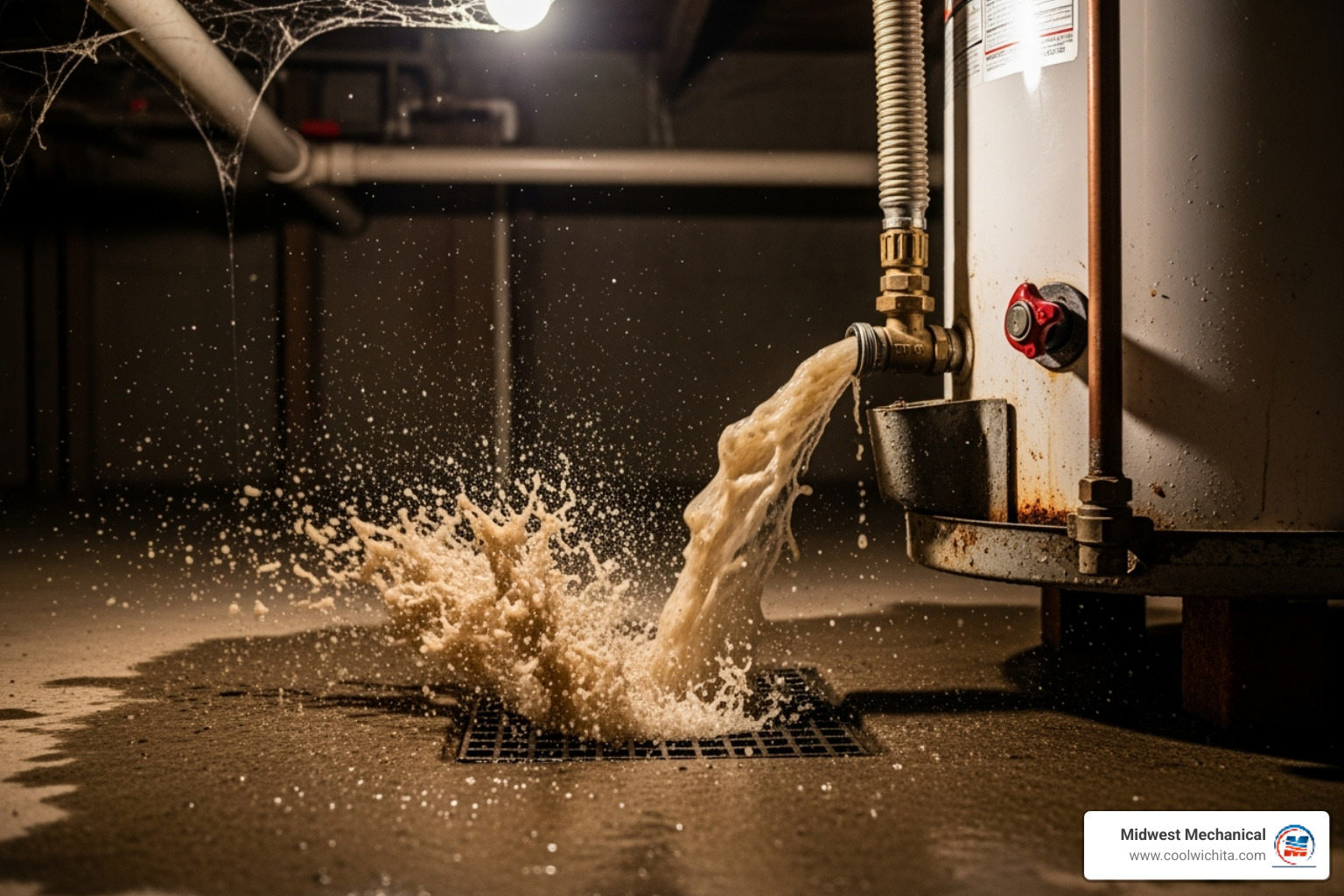Why You Suddenly Have No Hot Water: Quick Diagnosis Guide
A sudden lack of no hot water can be a frustrating start to your day. Whether the water is completely cold or just lukewarm, the problem often stems from a few common causes you can identify yourself.
Most Common Causes of No Hot Water:
- Tripped circuit breaker (electric heaters)
- Pilot light out (gas heaters)
- Faulty thermostat
- Failed heating elements (electric)
- Gas supply issues
- Sediment buildup
- Water heater age (most last about 10 years)
Many of these issues have simple solutions, but some require professional help, especially those involving gas lines or electrical work.
Your safety is paramount. If you smell gas (a rotten egg odor) near your water heater, leave the area immediately and call your gas company. Do not attempt any repairs.
Understanding your water heater is the first step to a quick fix. Problems typically differ based on whether you have a gas or electric unit in your Wichita home.

First Steps: Initial Checks When You Have No Hot Water
When you find you have no hot water, don't panic. While it's incredibly frustrating to face a cold shower on a busy morning, a methodical approach will help you identify the problem quickly and get your hot water flowing again.
Start by checking every hot water faucet in your home. Turn on the kitchen sink, bathroom sinks, and showers. Is just one fixture affected, or is this a whole-house problem? If only one faucet has cold water, you're likely dealing with a localized issue like a faulty mixing valve or disconnected supply line. But if every faucet runs cold, your water heater is the culprit.
Think about what happened before you noticed the no hot water situation. Did the power flicker during last night's storm? Even brief power outages can trip circuit breakers or affect electronic components in your water heater. Has your family been using more hot water than usual? Maybe you had guests staying over, or someone finded the joy of extra-long showers.
Don't overlook the obvious either. If you just returned from vacation, check whether someone switched your water heater to vacation mode. This energy-saving setting lowers the temperature, and it takes time for the tank to heat back up to your normal setting.

Is the Problem with the Power or the Heater?
Once you've confirmed this is a whole-house hot water problem, your next move is checking the power supply. Both electric and gas water heaters need electricity to function properly, even though gas units primarily use gas for heating.
For electric water heaters, head straight to your circuit breaker panel. Look for the breaker labeled "water heater" – it's usually a double breaker with two switches connected together. If it's tripped, the switch will be in the "off" position or stuck somewhere between "on" and "off."
Reset a tripped breaker by flipping it firmly to "off" first, then back to "on." You should hear a solid click when it engages properly. If the breaker immediately trips again, don't keep trying to reset it. This signals a serious electrical problem that needs professional attention right away.
Always use a non-contact voltage tester when working around electrical components. Safety isn't worth risking, even for a simple breaker reset.
Gas water heater owners should check their gas supply valve next. This valve, located on the gas line leading to your water heater, should be fully open (handle parallel to the pipe). Sometimes these get bumped or accidentally turned during cleaning.
Test whether gas is reaching your home by trying other gas appliances like your stove burners or furnace. If they're working normally, your main gas supply is fine, and the problem lies specifically with your water heater.
What to Do If You Suspect a Gas Leak
Here's where we get serious about safety. If you smell that distinctive rotten egg smell anywhere near your water heater, you might have a gas leak. Natural gas companies add this sulfur-like odor specifically so you can detect leaks quickly.
Follow this safety protocol immediately: Get everyone out of the house, including pets. Don't waste time gathering belongings – just leave. While evacuating, avoid creating any sparks or flames. That means no light switches, no cell phones, no matches, and definitely no attempts to find the source of the leak.
If you can do so safely while leaving, open windows and doors to ventilate the area. But don't spend extra time doing this if it delays your exit.
Once you're at a safe distance from your home, call your utility company immediately and dial 911. Professional emergency responders have the training and equipment to handle gas leaks safely. Never attempt to locate or repair a gas leak yourself.
Don't re-enter your home until emergency personnel give you the all-clear. Your safety is infinitely more important than a cold shower, and gas leaks can be deadly serious.
Diagnosing Your Water Heater: Gas vs. Electric Models
Once you've ruled out the simple stuff, it's time to get up close and personal with your water heater. Here's where things get interesting – and where knowing whether you have a gas or electric unit makes all the difference in getting your no hot water problem solved.

Electric water heaters use heating elements to warm water in the tank, while gas models use a flame from a burner. Both can fail, but for different reasons. Let's break down what typically goes wrong with each type.
Common Reasons for No Hot Water in Electric Heaters
The most common issues with electric water heaters are often related to power and components.
- Tripped High-Limit Switch: This safety feature (a small red reset button on the upper thermostat) cuts power if the water gets too hot. To reset it, turn off power at the circuit breaker, then press the button firmly. If it clicks, it was tripped. If it keeps tripping, call a professional.
- Faulty Thermostat: Electric heaters usually have two thermostats. If one fails, it won't tell the heating elements to turn on, resulting in lukewarm or cold water.
- Failed Heating Elements: These are the parts that heat your water. If one fails, you might get some warm water that runs out quickly. If both fail, you'll have cold showers until they're replaced. Signs include lukewarm water, tripping breakers, or higher energy bills.
Troubleshooting No Hot Water in Gas Heaters
Gas water heaters are more complex, but most problems follow predictable patterns.
- Pilot Light Out: Many gas heaters use a small, continuous flame (the pilot light) to ignite the main burner. If it's out, you'll have no hot water. You can usually see the flame through a small window. Relighting it requires following your owner's manual carefully, and always wait at least five minutes after turning off the gas for any lingering fumes to dissipate. For step-by-step guidance, check this resource on how to safely relight a pilot light.
- Faulty Thermocouple: This safety device shuts off the gas if it can't sense the pilot flame. If the pilot won't stay lit after relighting, the thermocouple is likely bad and needs replacement.
- Gas Valve Problems: Ensure the gas supply valve to your heater is fully open. If the pilot is lit but the main burner won't fire up, the gas control valve on the unit may be malfunctioning, which requires professional service.
- Electronic Ignition Systems: Newer models use an electronic igniter instead of a pilot light. If this system fails, you'll have no hot water. These units often have blinking lights or error codes to help with troubleshooting.
For more detailed information, you might find our guide on pilot light problems helpful.
Common Problems Affecting All Water Heater Types
Some issues don't care whether you have a gas or electric water heater – they can affect any traditional tank-style unit. These problems often relate to water quality, tank integrity, or overall system design.

How Sediment Buildup Stops Hot Water
Sediment buildup is a silent enemy of your water heater. In Wichita, our water contains minerals that settle at the bottom of the tank, creating a crusty layer. This layer acts as a blanket between the heating source and the water, forcing your heater to work harder.
This leads to rumbling noises, higher energy bills, and less available hot water. Regular tank flushing (at least once a year) can prevent this. The process involves draining the tank to remove the mineral deposits. For more information, check out our guide on water heater corrosion.
Identifying and Addressing a Leaking Water Heater
A leaking water heater can cause no hot water and significant property damage. Look for puddles, dripping sounds, or rust around the unit.
- Connection and Valve Leaks: Drips from pipe connections or valves can often be repaired. However, if your temperature and pressure (T&P) relief valve is constantly releasing water, it signals a pressure problem that needs immediate professional attention.
- Tank Leaks: If water is seeping from the tank itself, it means the tank has corroded from the inside. This cannot be repaired, and the entire water heater needs to be replaced. This is why most units have a lifespan of about 10 years.
If you notice a leak, don't wait. Read our guide on how to fix a water heater leak quickly for immediate steps.
Tank vs. Tankless Water Heater Troubleshooting
While most Wichita homes have traditional tank water heaters, tankless models are becoming popular. When you have no hot water, the troubleshooting approach differs significantly.
| Problem Type | Tank Water Heater Issues | Tankless Water Heater Issues |
|---|---|---|
| Heating Failure | Failed heating elements, pilot light out, thermostat problems, sediment insulation | Ignition failure, gas valve issues, flame sensor problems |
| Water Flow Issues | Broken dip tube, sediment blockage, tank capacity exceeded | Flow sensor malfunction, minimum flow not met, water pressure problems |
| Mineral Problems | Sediment settles at bottom, insulates heating elements, reduces capacity | Mineral buildup in heat exchanger, scale formation, restricted water flow |
| Component Wear | Anode rod depletion, tank corrosion, element burnout | Heat exchanger corrosion, electronic control failures, venting issues |
Tankless systems are more complex and often display error codes for issues like ignition failure or mineral buildup. Traditional tank failures are often more gradual, caused by problems like a broken dip tube (giving you lukewarm water) or a depleted anode rod that accelerates corrosion.
First Steps: Initial Checks When You Have No Hot Water
When you find you have no hot water, a systematic approach can help you pinpoint the problem quickly. Start with these simple checks before inspecting the water heater itself.
- Check All Faucets: Is the issue with a single faucet or your entire home? If it's just one, the problem is likely with that fixture's mixing valve. If it's a whole-house issue, the water heater is the culprit.
- Consider Recent Events: Did the power go out recently? A brief outage can trip a circuit breaker or affect electronic igniters. Has your hot water usage been higher than normal? The tank may just need time to reheat. Also, check if the unit is in "vacation mode," which lowers the temperature.

Is the Problem with the Power or the Heater?
Once you confirm it's a whole-house problem, check the power supply. Both gas and electric heaters need electricity to function.
- For Electric Heaters: Go to your circuit breaker panel and find the breaker labeled "water heater." If it's tripped (in the "off" or middle position), flip it fully to "off" and then back to "on." If it trips again immediately, there is a serious electrical problem that requires a professional.
- For Gas Heaters: Check if other gas appliances, like your stove, are working. If they are, the main gas supply is fine. Then, ensure the gas supply valve on the line to your water heater is fully open (handle parallel to the pipe).
What to Do If You Suspect a Gas Leak
A rotten egg smell near your gas water heater indicates a potential gas leak. This is an emergency.
If you smell gas, follow these steps immediately:
- Evacuate: Get everyone out of the house immediately.
- Do Not Create Sparks: Avoid using light switches, phones, or any appliances.
- Ventilate (If Safe): Open doors and windows on your way out, but do not delay your exit.
- Call for Help: From a safe distance, call your gas utility company and 911.
- Stay Out: Do not re-enter your home until emergency personnel declare it safe.
Never attempt to fix a gas leak yourself. Your safety is the top priority.
Diagnosing Your Water Heater: Gas vs. Electric Models
Once you've checked the basics, focus on your specific water heater type. Electric and gas units fail for different reasons, so the troubleshooting steps differ.
Electric water heaters use heating elements powered by electricity; gas models use a burner fueled by natural gas or propane.
Common Reasons for No Hot Water in Electric Heaters
Tripped High-Limit Switch (Reset Button): This safety device cuts power if water overheats. Turn off power at the breaker, press the red reset on the upper thermostat, then restore power. If it trips again, call a professional.
Faulty Thermostat: Electric heaters typically have upper and lower thermostats. If one fails or is mis-set, elements won’t heat properly, causing lukewarm or cold water. Verify setpoints (commonly 120–140°F). If issues persist, the thermostat may need replacement.
Failed Heating Elements: If an element burns out, you’ll get no or insufficient hot water.
Signs:
- No hot water (both elements failed)
- Lukewarm water or hot water that runs out quickly (one element failed)
- Breaker tripping (shorted element)
- Slow recovery
Element testing/replacement involves high voltage—best left to a pro.
Troubleshooting No Hot Water in Gas Heaters
Pilot Light Out: Older units use a standing pilot to ignite the burner. Check the viewing window. To relight, follow your owner’s manual and wait at least 5 minutes after turning gas off before re-igniting. Step-by-step help: How to safely relight a pilot light.
Faulty Thermocouple: If the pilot won’t stay lit, the thermocouple may not sense the flame and will shut off gas. Replacement is typically required.
Gas Valve Problems: Ensure the gas supply valve to the heater is fully open. If the pilot is lit but the main burner won’t fire, the gas control valve or supply may be at fault—call a technician.
Electronic Igniter Issues (Newer Models): Units without a standing pilot use a spark or glow igniter. If it fails, the burner won’t light. Look for blinking codes on the control; service may be needed.
For more insights into common pilot issues, see More on pilot light problems.
Common Problems Affecting All Water Heater Types
Some issues hit both gas and electric tank-style units (and even some tankless models). Water quality, tank integrity, and system design are common themes.
How Sediment Buildup Stops Hot Water
Hard water minerals (calcium, magnesium) settle at the bottom of the tank, forming insulating sediment that:
- Reduces efficiency and hot water capacity
- Causes rumbling/popping sounds
- Can overheat and damage elements or the tank
Flush your tank annually to limit sediment:
- Turn off power or gas and close the cold-water supply valve.
- Attach a garden hose to the drain valve and route to a floor drain or outdoors.
- Open a hot faucet in the house to relieve vacuum; open the drain valve to empty the tank.
- Briefly open the cold-water valve to stir remaining sediment; drain until water runs clear.
- Close the drain, remove the hose, close the hot faucet, and reopen the cold-water supply to refill.
- Once water flows steadily at a hot faucet, restore power or gas.
Learn more about preventing corrosion here: More on water heater corrosion.
Identifying and Addressing a Leaking Water Heater
Signs:
- Puddles around the unit or dripping sounds
- Rust or corrosion on tank/connections
- Reduced hot water pressure
What the leak means:
- Connections/Valves: Often repairable (tighten fittings, replace faulty valves). A frequently discharging T&P valve indicates a pressure/temperature issue—get service.
- Tank Body: Internal corrosion means replacement; tanks can’t be repaired once they leak.
Immediate steps and safety tips: How to fix a water heater leak quickly.
Tank vs. Tankless Water Heater Troubleshooting
- Heating failures:
- Tank: burnt elements, pilot out, thermostat issues, sediment insulating heat source.
- Tankless: ignition/gas valve faults, flame sensor issues.
- Water flow/pressure:
- Tank: broken dip tube, sediment blockage, undersized tank.
- Tankless: minimum flow not met, flow sensor or scale restricting heat exchanger.
- Mineral/scale:
- Tank: sediment at bottom reduces capacity and efficiency.
- Tankless: scale in heat exchanger restricts flow and heat transfer; periodic descaling required.
If you see error codes (common on tankless units) or persistent symptoms after basic checks, schedule professional service.
Customer Testimonials
Hear from satisfied customers who trust us for reliable HVAC and plumbing service across Wichita.






Plus, the technician, Lee was very professional, knowledgeable and informative.
We will definitely be doing business with them sometime again in the past.


I'm prompt to my appointment. Thank you Midwest Mechanical.









We have partnered with GoodLeap to offer flexible payment options for your project. GoodLeap uses a soft credit check until funding and the highest score from all 3 bureaus to see if you qualify. It also takes just a few minutes to get started.








.svg)